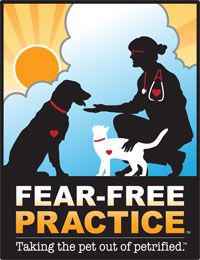Top 10 ways to get started with Fear-Free veterinary visits (Sponsored by Boehringer Ingelheim Vetmedica Inc., Ceva, and Elanco)
The Fear-Free initiative promotes the practices, methods, and tools that calm veterinary patients and create low-stress environments to encourage better healthcare, more satisfied and compliant clients, a happier staff, and a healthier bottom line. Here are 10 steps toward Fear-Free visits to take the pet out of petrified and get pets back into your practice.

The Fear-Free™ initiative, with Dr. Marty Becker at its head, promotes the practices, methods, and tools that calm veterinary patients and create low-stress environments to encourage better healthcare, more satisfied and compliant clients, a happier staff, and a healthier bottom line. Here are 10 steps toward Fear-Free™ visits to take the “pet” out of “petrified” and get pets back into your practice.
1. Help the pet owner deliver a calm pet to your clinic. The Fear-Free™ veterinary visit (like pain control) is best created with a multimodal approach that must involve the pet owner. The owner's role in taking a pet to the veterinarian must fundamentally change. The owner should condition the pet to the carrier or restraint device and to car rides long before the day of the veterinary visit. Cats should be allowed to use their carriers daily as a resting place so that the carrier is familiar and comfortable, rather than something associated with a frightening car ride. Also, you and your veterinary team should learn to detect fear early by asking owners about the anxiety their pets experience. If you don't ask, you may miss it. Don't wait for advanced signs, such as a dog hiding under the exam room chair or a cat lashing out.
To keep the pet calm on the day of an appointment, instruct pet owners to use Adaptil™ or Feliway® pheromones (Ceva), calming nutraceuticals, and carrier covers. Owners will need to remain calm themselves. They may find it helpful to play special calming music and use aromatherapy in the car. Some pets may require prescription anxiolytic medication before they leave home.
2. Instruct the owner to limit food before an appointment so treats are more effective. If the pet's appointment is around its meal time, the pet owner should feed a smaller amount of the pet's food (unless medically contraindicated). This is so the pet will respond better to food rewards at the veterinary hospital. Also, instruct the owner to bring the pet's favorite treats to the appointment.
3. Minimize use of the clinic waiting area. If your practice has enough exam rooms and the technology to do so, consider conducting check-ins for fearful pets in the exam room or a holding room. The pet owner could take the pet directly into an exam room, or the owner could check in alone and then return to the vehicle to wait until the pet can be ushered directly into an available exam room. It is best for the veterinarian and the technician to have already entered the room before the pet arrives. If the waiting room is large, calming, and quiet, a dog or cat can stay there for about 10 minutes. Even a small waiting room can be made more pleasant by including visual barriers, such as plants or shelves, so that owners can wait and not have other animals right next to them. Shelves can be used to place cat carriers on, rather than on the floor where the cat can be investigated by every dog that passes by.
4. Designate species-specific exam rooms. When possible, assign specific exam rooms to a single species. These will be species-specific places to examine pets and will incorporate pheromones, calming music, and wall coverings. Pheromones are also a great tool when species-specific rooms are not practical in a small clinic. They can be used at the same time; they won't affect the other species. The temperature in the exam room can also be carefully controlled (using a silent space heater).
5. Create a sense of calm in the exam room. Veterinarians and technicians should be in the room before the pet enters. Avoid direct eye contact with the pet, and wait for the pet to initiate interaction. Toss lots of tiny treats near the pet, so that it doesn't have to come near you to retrieve them. Lower your voice; don't be hurried; let dogs sniff instruments (stethoscope, otoscope, etc.) before you use them. When examination of a painful area is necessary, consider topical pain management to reduce sensitivity. Let cats get used to the room by taking the top off their carrier early in the appointment and provide a towel for them to hide under. Be sure that you have a nonslip surface on the exam table to reduce the pet's fear and anxiety.
6. Choose the best location to examine the pet. Rather than just hoisting the dog or the cat carrier onto the exam table, explore alternate places to conduct your examination, including in the carrier (with the top removed), on the floor (with a yoga mat or towel), or on the pet owner's lap.
7. Figure out the best method of positional compliance. Gone are the days of wrestling pets to the table. Work with the pet to find out a method of control that keeps the pet calm but still allows you to perform procedures. Once you know which method works best, note that in the patient record, along with other information you've gathered, such as the pet's preferred place to be examined, favorite treats, her tricks, and cue words.

8. Make the vaccination experience more comfortable. Be sure to always employ your best distraction techniques. Make vaccinations less stressful by choosing options that use small-gauge needles or that offer a reduced dose (such as ULTRA™ Duramune® for dogs and ULTRA™ Fel-O-Vax® for cats [Boehringer Ingelheim Vetmedica Inc.]). When possible, choose vaccines that can be administered via a less stressful route (such as the Bronchi-Shield® ORAL Bordetella bronchiseptica vaccine [Boehringer Ingelheim Vetmedica Inc.], which requires no needles at all). When injection is necessary, consider topical pain management before the injection.
9. Sedate early and often. Sedation is not a last resort. Depending on the practice, many pets are so psychologically damaged or fearful that they will require sedation before they leave home. Once a pet is at your hospital, if it is fearful and won't take a tasty food reward, even if hungry, it's time to regroup. You can either sedate the pet and wait for the sedative to take effect or reschedule the appointment for a later time when Fear-Free™ techniques and tools can be implemented. Consider the reason for the visit, and if pain management is required, begin it early. For example, if a dog has a painful ear, it may be better to administer a pain-relief medication as its pre-appointment medication. When procedures are not an emergency, pets can be sent home and return for “happy visits” or desensitization exercises to prepare them for future handling without sedation. Even a very fearful pet can be taught to tolerate procedures with time and effort.
10. Cradle every pet's emotional and physical well-being. Always start by looking after the pet's emotional well-being. Only after you're confident the pet is calm or you've administered a sedative that has taken effect should you continue your exam or procedure. That is, first look after the pet's emotional well-being and then its physical well-being. Familiarize yourself with and apply the information in these excellent books:
• Low Stress Handling, Restraint and Behavior Modification of Dogs and Cats: Techniques for Developing Patients Who Love Their Visits by Dr. Sophia Yin (CattleDog Publishing, 2009; ISBN 978-0964151840)
• Decoding Your Dog: The Ultimate Experts Explain Common Dog Behaviors and Reveal How to Prevent or Change Unwanted Ones by American College of Veterinary Behaviorists (Houghton Mifflin Harcourt, 2014; ISBN: 978-0547738918)
For more helpful resources, visit the Fear-Free center at dvm360.com/FearFree.

Dr. Marty Becker is a syndicated columnist, author of 24 pet books, the resident veterinarian on The Dr. Oz Show (was the resident veterinarian for Good Morning America for 17 years), is an adjunct professor at three veterinary schools (his alma mater Washington State, Colorado State, and University of Missouri) and the leader of the Fear-Free™ initiative. As a media personality, author, lecturer, educator, contributor, and recipient of numerous awards, Dr. Marty Becker has become known as “America's veterinarian.” Dr. Becker practices at North Idaho Animal Hospital in Sandpoint, Idaho.
Newsletter
From exam room tips to practice management insights, get trusted veterinary news delivered straight to your inbox—subscribe to dvm360.